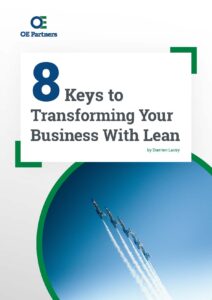Lean principles applied to a new premises delivered cutting-edge warehousing processes
The business challenge
Founded in 1925, Bob Stewart Pty Ltd is a third generation family business that specialises in the supply and retail of uniforms for more than 40 independent and state schools in Melbourne. Brothers Robert and Francis joined the business in the early 1990s, and embrace their family values of exemplary customer service and business integrity. Bob Stewart has retail stores in Kew, Malvern and Mentone, but it was the pending move to a much larger new warehouse in August 2017 that prompted management to call in OE Partners. The company is enjoying considerable growth, and wanted to strengthen operational processes and drive further efficiencies in the business.
The approach
OE Partners identified three areas of opportunity: new warehouse operations and layout review; embroidery process improvement; and supply, demand and planning review. It was agreed that the most pressing issue was optimising operations in the warehouse, and ensuring that greater efficiencies were achieved.
The results
The operational assessment and ‘quick win’ action plan was completed in two weeks, with the new warehouse design following four weeks later. New technology was identified, sourced and priced in four weeks, and implementation with new equipment, systems, processes and stock was completed in two months. Greater efficiency, accuracy and faster turnaround were swiftly evident, and the company believes it will eventually save two full time staff positions.
Lean principles applied to new premises
deliver cutting-edge warehousing processes
Annual growth of around 10 per cent for the past few years made the move to a much larger warehouse inevitable for uniform suppliers Bob Stewart Pty Ltd. This decision also provided the ideal opportunity for third-generation management Robert Stewart and Francis Stewart to implement new warehousing systems and processes, and to develop much greater staff expertise in this area.
“We realised we needed a larger warehouse, but we had also come to realise that as our business grew, it had become more complex,” says Robert Stewart. “Existing systems, which had grown like Topsy, were no longer adequate, and we really needed a more structured approach.”
OE Partners were called in to review layouts in the existing 1000 sq m warehouse, and to advise on setting up and operating the new 2500 sq m premises.
Goals included:
- More reliable and less wasteful operating processes that are less reliant on the skills and knowledge of a few staff.
- Identification of current weaknesses in operations.
- Completion of a gap analysis plan to bring warehouse operations closer to best practice for quality and customer service.
- Development of measures and controls for better business management, including KPIs that would change behaviour.
- Design of an optimal layout for the new warehouse that would maximise capacity and support changes to operational processes.
“The Stewarts did not see themselves as experts in warehousing or supply chain, and were aware of overcrowding and picking errors in the warehouse,” says OE Partners.
“However, close inspection of their operations revealed other areas where significant improvements could be made.”
These included:
- No location numbering, which meant picking required product and customer knowledge, precluding use of casual pickers.
- A maximum picking height of 3 metres, due to a lack of materials handling equipment such as forklifts.
- A ratio of one warehouse aisle to one row of racking, which limited storage capacity.
- No designated inwards and outwards stock area, due to lack of space.
- Manual recording of all picks, with no scan technology.
- Products stored by customer instead of by frequency of picking.
- More than 50% of boxes in school bays required double or multiple handling.
- Shelf height was not matched to carton height, therefore space could not be maximised.
- No computer at Receiving, meaning manual searches for PO records and printing of labels and barcodes.
- Some potential safety risks, such as manual storage processes and use of stepladders.
“The new warehouse design and equipment includes man up stock pickers, which enable staff to pick up to 5 metres in height. Stock pickers also allow a narrow aisle layout and further increase warehouse capacity,” OE Partners says.
“The ratio of 1:1 warehouse aisle to row of racking was changed to 2:1 aisle to racking. By putting racks back to back, storage capacity was effectively increased by more than 40%.”
Standard carton sizes were agreed, and location heights adjusted to manage multiples.
“The new design has fast-moving products in easier access locations, configured to a better carton size based on volume. This allows faster picking from the front and replenishment from the back so the warehouse never runs out of stock.
“All items have product barcodes and are stored in numbered locations, with new scanning technology eliminating pick errors.”
A computer terminal was introduced at Receiving, allowing operators to check POs, print labels and thus free up the supervisor.
5S training was introduced for six staff, who were involved in 5S projects to plan the layout of Receiving and Dispatch docks. New KPIs were introduced for customer service, quality and productivity.
“OE Partners were very proactive in getting onsite, getting a good understanding of exactly what our needs were, and providing excellent feedback,” Robert says.
“We’ve got much better structure and processes in place to handle our inventory, and we’ll have much greater efficiency and effectiveness in the warehouse. That will give us faster turnaround and greater accuracy with stock picking.”
“In terms of value for money, we feel confident that the money has been well spent because we will save that many times over.”
Robert Stewart, Co-Owner, Bob Stewarts Pty Ltd


